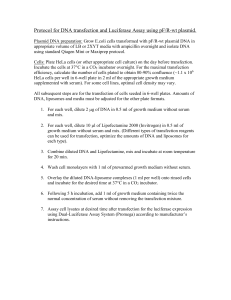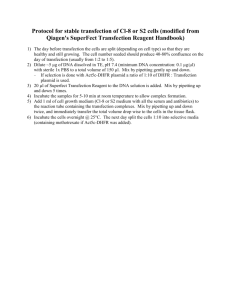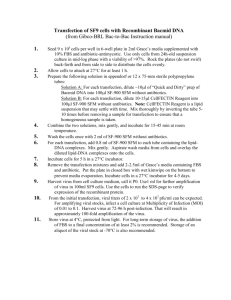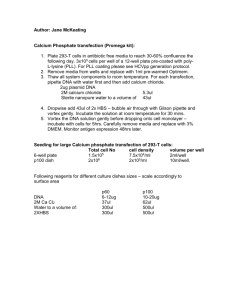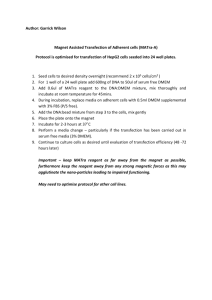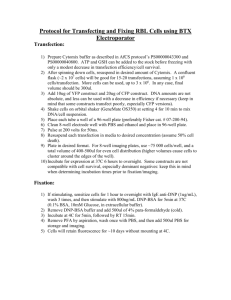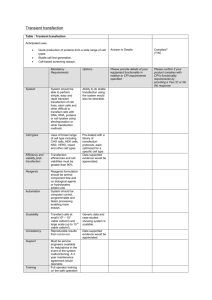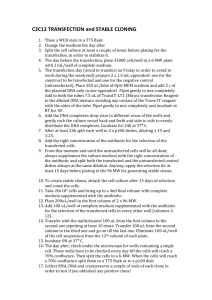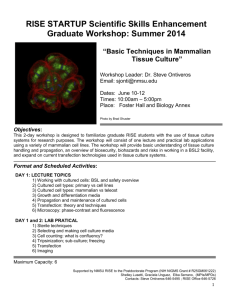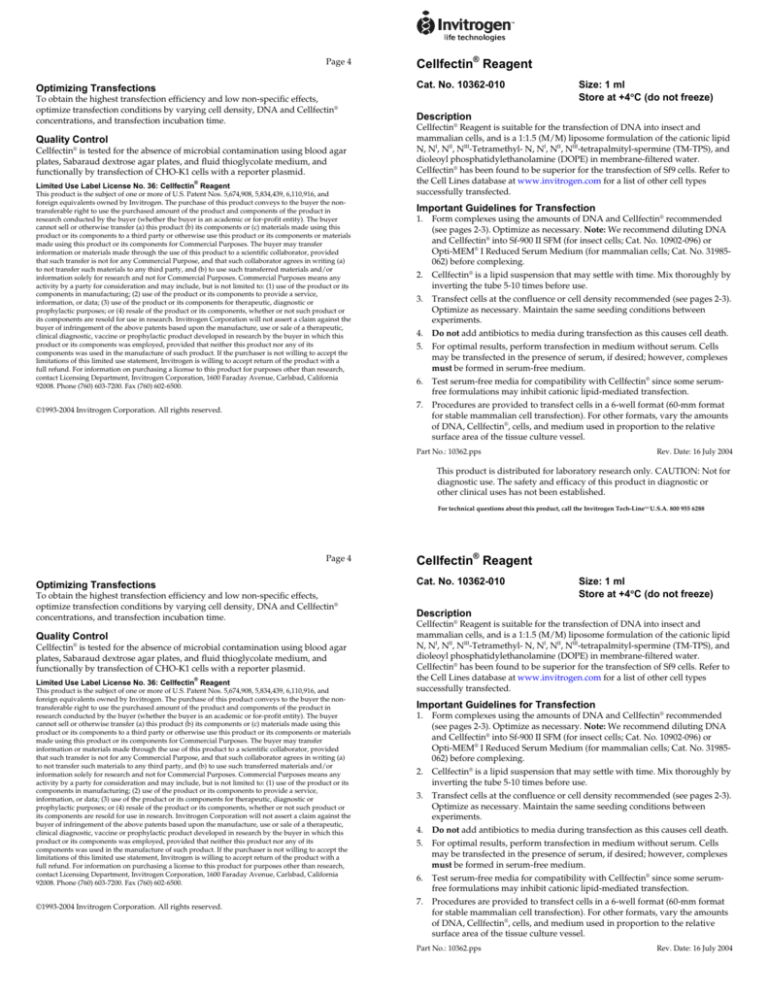
Page 4
Cellfectin® Reagent
Cat. No. 10362-010
Optimizing Transfections
To obtain the highest transfection efficiency and low non-specific effects,
optimize transfection conditions by varying cell density, DNA and Cellfectin®
concentrations, and transfection incubation time.
Quality Control
Cellfectin® is tested for the absence of microbial contamination using blood agar
plates, Sabaraud dextrose agar plates, and fluid thioglycolate medium, and
functionally by transfection of CHO-K1 cells with a reporter plasmid.
®
Limited Use Label License No. 36: Cellfectin Reagent
This product is the subject of one or more of U.S. Patent Nos. 5,674,908, 5,834,439, 6,110,916, and
foreign equivalents owned by Invitrogen. The purchase of this product conveys to the buyer the nontransferable right to use the purchased amount of the product and components of the product in
research conducted by the buyer (whether the buyer is an academic or for-profit entity). The buyer
cannot sell or otherwise transfer (a) this product (b) its components or (c) materials made using this
product or its components to a third party or otherwise use this product or its components or materials
made using this product or its components for Commercial Purposes. The buyer may transfer
information or materials made through the use of this product to a scientific collaborator, provided
that such transfer is not for any Commercial Purpose, and that such collaborator agrees in writing (a)
to not transfer such materials to any third party, and (b) to use such transferred materials and/or
information solely for research and not for Commercial Purposes. Commercial Purposes means any
activity by a party for consideration and may include, but is not limited to: (1) use of the product or its
components in manufacturing; (2) use of the product or its components to provide a service,
information, or data; (3) use of the product or its components for therapeutic, diagnostic or
prophylactic purposes; or (4) resale of the product or its components, whether or not such product or
its components are resold for use in research. Invitrogen Corporation will not assert a claim against the
buyer of infringement of the above patents based upon the manufacture, use or sale of a therapeutic,
clinical diagnostic, vaccine or prophylactic product developed in research by the buyer in which this
product or its components was employed, provided that neither this product nor any of its
components was used in the manufacture of such product. If the purchaser is not willing to accept the
limitations of this limited use statement, Invitrogen is willing to accept return of the product with a
full refund. For information on purchasing a license to this product for purposes other than research,
contact Licensing Department, Invitrogen Corporation, 1600 Faraday Avenue, Carlsbad, California
92008. Phone (760) 603-7200. Fax (760) 602-6500.
©1993-2004 Invitrogen Corporation. All rights reserved.
Size: 1 ml
Store at +4°C (do not freeze)
Description
Cellfectin® Reagent is suitable for the transfection of DNA into insect and
mammalian cells, and is a 1:1.5 (M/M) liposome formulation of the cationic lipid
N, NI, NII, NIII-Tetramethyl- N, NI, NII, NIII-tetrapalmityl-spermine (TM-TPS), and
dioleoyl phosphatidylethanolamine (DOPE) in membrane-filtered water.
Cellfectin® has been found to be superior for the transfection of Sf9 cells. Refer to
the Cell Lines database at www.invitrogen.com for a list of other cell types
successfully transfected.
Important Guidelines for Transfection
1. Form complexes using the amounts of DNA and Cellfectin® recommended
(see pages 2-3). Optimize as necessary. Note: We recommend diluting DNA
and Cellfectin® into Sf-900 II SFM (for insect cells; Cat. No. 10902-096) or
Opti-MEM® I Reduced Serum Medium (for mammalian cells; Cat. No. 31985062) before complexing.
2. Cellfectin® is a lipid suspension that may settle with time. Mix thoroughly by
inverting the tube 5-10 times before use.
3. Transfect cells at the confluence or cell density recommended (see pages 2-3).
Optimize as necessary. Maintain the same seeding conditions between
experiments.
4. Do not add antibiotics to media during transfection as this causes cell death.
5. For optimal results, perform transfection in medium without serum. Cells
may be transfected in the presence of serum, if desired; however, complexes
must be formed in serum-free medium.
6. Test serum-free media for compatibility with Cellfectin® since some serumfree formulations may inhibit cationic lipid-mediated transfection.
7. Procedures are provided to transfect cells in a 6-well format (60-mm format
for stable mammalian cell transfection). For other formats, vary the amounts
of DNA, Cellfectin®, cells, and medium used in proportion to the relative
surface area of the tissue culture vessel.
Part No.: 10362.pps
Rev. Date: 16 July 2004
This product is distributed for laboratory research only. CAUTION: Not for
diagnostic use. The safety and efficacy of this product in diagnostic or
other clinical uses has not been established.
For technical questions about this product, call the Invitrogen Tech-LineSM U.S.A. 800 955 6288
Page 4
Optimizing Transfections
To obtain the highest transfection efficiency and low non-specific effects,
optimize transfection conditions by varying cell density, DNA and Cellfectin®
concentrations, and transfection incubation time.
Quality Control
Cellfectin® is tested for the absence of microbial contamination using blood agar
plates, Sabaraud dextrose agar plates, and fluid thioglycolate medium, and
functionally by transfection of CHO-K1 cells with a reporter plasmid.
Limited Use Label License No. 36: Cellfectin® Reagent
This product is the subject of one or more of U.S. Patent Nos. 5,674,908, 5,834,439, 6,110,916, and
foreign equivalents owned by Invitrogen. The purchase of this product conveys to the buyer the nontransferable right to use the purchased amount of the product and components of the product in
research conducted by the buyer (whether the buyer is an academic or for-profit entity). The buyer
cannot sell or otherwise transfer (a) this product (b) its components or (c) materials made using this
product or its components to a third party or otherwise use this product or its components or materials
made using this product or its components for Commercial Purposes. The buyer may transfer
information or materials made through the use of this product to a scientific collaborator, provided
that such transfer is not for any Commercial Purpose, and that such collaborator agrees in writing (a)
to not transfer such materials to any third party, and (b) to use such transferred materials and/or
information solely for research and not for Commercial Purposes. Commercial Purposes means any
activity by a party for consideration and may include, but is not limited to: (1) use of the product or its
components in manufacturing; (2) use of the product or its components to provide a service,
information, or data; (3) use of the product or its components for therapeutic, diagnostic or
prophylactic purposes; or (4) resale of the product or its components, whether or not such product or
its components are resold for use in research. Invitrogen Corporation will not assert a claim against the
buyer of infringement of the above patents based upon the manufacture, use or sale of a therapeutic,
clinical diagnostic, vaccine or prophylactic product developed in research by the buyer in which this
product or its components was employed, provided that neither this product nor any of its
components was used in the manufacture of such product. If the purchaser is not willing to accept the
limitations of this limited use statement, Invitrogen is willing to accept return of the product with a
full refund. For information on purchasing a license to this product for purposes other than research,
contact Licensing Department, Invitrogen Corporation, 1600 Faraday Avenue, Carlsbad, California
92008. Phone (760) 603-7200. Fax (760) 602-6500.
©1993-2004 Invitrogen Corporation. All rights reserved.
Cellfectin® Reagent
Cat. No. 10362-010
Size: 1 ml
Store at +4°C (do not freeze)
Description
Cellfectin® Reagent is suitable for the transfection of DNA into insect and
mammalian cells, and is a 1:1.5 (M/M) liposome formulation of the cationic lipid
N, NI, NII, NIII-Tetramethyl- N, NI, NII, NIII-tetrapalmityl-spermine (TM-TPS), and
dioleoyl phosphatidylethanolamine (DOPE) in membrane-filtered water.
Cellfectin® has been found to be superior for the transfection of Sf9 cells. Refer to
the Cell Lines database at www.invitrogen.com for a list of other cell types
successfully transfected.
Important Guidelines for Transfection
1. Form complexes using the amounts of DNA and Cellfectin® recommended
(see pages 2-3). Optimize as necessary. Note: We recommend diluting DNA
and Cellfectin® into Sf-900 II SFM (for insect cells; Cat. No. 10902-096) or
Opti-MEM® I Reduced Serum Medium (for mammalian cells; Cat. No. 31985062) before complexing.
2. Cellfectin® is a lipid suspension that may settle with time. Mix thoroughly by
inverting the tube 5-10 times before use.
3. Transfect cells at the confluence or cell density recommended (see pages 2-3).
Optimize as necessary. Maintain the same seeding conditions between
experiments.
4. Do not add antibiotics to media during transfection as this causes cell death.
5. For optimal results, perform transfection in medium without serum. Cells
may be transfected in the presence of serum, if desired; however, complexes
must be formed in serum-free medium.
6. Test serum-free media for compatibility with Cellfectin® since some serumfree formulations may inhibit cationic lipid-mediated transfection.
7. Procedures are provided to transfect cells in a 6-well format (60-mm format
for stable mammalian cell transfection). For other formats, vary the amounts
of DNA, Cellfectin®, cells, and medium used in proportion to the relative
surface area of the tissue culture vessel.
Part No.: 10362.pps
Rev. Date: 16 July 2004
Page 2
Transfecting Insect Cells with Baculovirus DNA
Use this procedure to transfect Sf9 insect cells in a 6-well format. All amounts
and volumes are given on a per well basis.
1. Plate 9 x 105 Sf9 cells in 2 ml of Sf-900 II SFM containing antibiotics (i.e.
penicillin/streptomycin/neomycin; Cat. No. 15640-055) at 0.5X final
concentration. Allow cells to attach for at least 1 hour.
2. For each transfection sample, prepare complexes as follows:
a. Dilute 1-2 µg of baculovirus DNA in 100 µl of Sf-900 II SFM without
antibiotics.
b. Mix Cellfectin® before use, then dilute 1.5-9 µl in 100 µl of Sf-900 II SFM
without antibiotics.
3.
4.
5.
6.
c. Combine the diluted DNA with diluted Cellfectin® (total volume = 200 µl).
Mix gently and incubate for 15-45 minutes at room temperature (solution
may appear cloudy).
Remove the growth medium from the cells and wash once with Sf-900 II SFM
without antibiotics. Remove the wash medium.
Add 0.8 ml of Sf-900 II SFM to the complexes (Step 2c), mix gently and add to
the cells. Incubate cells at 27°C for 5 hours.
Remove the transfection mixture and replace with 2 ml of Sf-900 II SFM
containing antibiotics. Incubate cells at 27°C for 48 hours.
Assay for gene activity at 48 hours post-transfection; harvest virus at
72 hours.
Transfecting Adherent Mammalian Cells
Use the following procedure to transiently or stably transfect mammalian cells.
All amounts and volumes are given on a per well basis.
1. One day before transfection, plate cells in growth medium without antibiotics
such that they will be at the recommended confluence at the time of
transfection.
Condition
Transient
Stable
Cell no.
1-2 x 105
1-2 x 105
Growth med. vol.
2 ml
4 ml
Format
6-well
60-mm
Page 3
2. For each transfection sample, prepare complexes as follows:
Confluence at txfn
60-80%
30-50%
a. Dilute 1-2 µg of DNA in 100 µl of Opti-MEM® I Reduced Serum Medium
(or other medium) without serum.
b. Mix Cellfectin® before use, then dilute 2-15 µl of Cellfectin® in 100 µl of
Opti-MEM® I Medium (or other medium) without serum.
c. Combine the diluted DNA with diluted Cellfectin® (total volume =
200 µl). Mix gently and incubate for 10-15 minutes (15-45 minutes for
stable transfection) at room temperature (solution may appear cloudy).
3. Remove the growth medium from the cells and wash once with 2 ml of
growth medium without serum. Remove the wash medium.
4. Add 0.8 ml of Opti-MEM® I Medium without serum (1.8 ml for stable
transfection) to the complexes (Step 2c), mix gently and add to cells.
5. Incubate cells at 37°C in a CO2 incubator for 5-24 hours.
6. Replace the medium with 2 ml of growth medium containing serum (4 ml
for stable transfection).
7. Transient: Test for transgene expression 24-72 hours post-transfection.
Stale cell lines: Passage cells at a 1:5 (or higher dilution) into selective
medium 48-72 hours post-transfection.
Transfecting Suspension Mammalian Cells (6-well format)
1. For each transfection sample, form complexes as in Step 2 of the protocol
above, with the following exceptions: (1) Dilute DNA and Cellfectin® into
0.5 ml of Opti-MEM® I Medium each and (2) Incubate complexes for 15-45
minutes at room temperature.
2. For each transfection sample, centrifuge 2 x 106 cells and aspirate medium.
3. Resuspend the cell pellet with the DNA-lipid complex solution (Step 1) and
transfer to a well of a 6-well plate. Incubate at 37°C in a CO2 incubator for
4-5 hours.
4. Add 0.5 ml of growth medium containing 30% fetal bovine serum. Note:
Add PMA and/or PHA, if desired, to enhance promoter activity and gene
expression.
5. The following day, add 1-2 ml of complete growth medium. Assay for
transgene expression 24-48 hours post-transfection.
Page 2
Transfecting Insect Cells with Baculovirus DNA
Use this procedure to transfect Sf9 insect cells in a 6-well format. All amounts
and volumes are given on a per well basis.
1. Plate 9 x 105 Sf9 cells in 2 ml of Sf-900 II SFM containing antibiotics (i.e.
penicillin/streptomycin/neomycin; Cat. No. 15640-055) at 0.5X final
concentration. Allow cells to attach for at least 1 hour.
2. For each transfection sample, prepare complexes as follows:
a. Dilute 1-2 µg of baculovirus DNA in 100 µl of Sf-900 II SFM without
antibiotics.
b. Mix Cellfectin® before use, then dilute 1.5-9 µl in 100 µl of Sf-900 II SFM
without antibiotics.
3.
4.
5.
6.
c. Combine the diluted DNA with diluted Cellfectin® (total volume = 200 µl).
Mix gently and incubate for 15-45 minutes at room temperature (solution
may appear cloudy).
Remove the growth medium from the cells and wash once with Sf-900 II SFM
without antibiotics. Remove the wash medium.
Add 0.8 ml of Sf-900 II SFM to the complexes (Step 2c), mix gently and add to
the cells. Incubate cells at 27°C for 5 hours.
Remove the transfection mixture and replace with 2 ml of Sf-900 II SFM
containing antibiotics. Incubate cells at 27°C for 48 hours.
Assay for gene activity at 48 hours post-transfection; harvest virus at
72 hours.
Transfecting Adherent Mammalian Cells
Use the following procedure to transiently or stably transfect mammalian cells.
All amounts and volumes are given on a per well basis.
1. One day before transfection, plate cells in growth medium without antibiotics
such that they will be at the recommended confluence at the time of
transfection.
Condition
Transient
Stable
Cell no.
1-2 x 105
1-2 x 105
Growth med. vol.
2 ml
4 ml
Format
6-well
60-mm
Confluence at txfn
60-80%
30-50%
Page 3
2. For each transfection sample, prepare complexes as follows:
a. Dilute 1-2 µg of DNA in 100 µl of Opti-MEM® I Reduced Serum Medium
(or other medium) without serum.
b. Mix Cellfectin® before use, then dilute 2-15 µl of Cellfectin® in 100 µl of
Opti-MEM® I Medium (or other medium) without serum.
c. Combine the diluted DNA with diluted Cellfectin® (total volume =
200 µl). Mix gently and incubate for 10-15 minutes (15-45 minutes for
stable transfection) at room temperature (solution may appear cloudy).
3. Remove the growth medium from the cells and wash once with 2 ml of
growth medium without serum. Remove the wash medium.
4. Add 0.8 ml of Opti-MEM® I Medium without serum (1.8 ml for stable
transfection) to the complexes (Step 2c), mix gently and add to cells.
5. Incubate cells at 37°C in a CO2 incubator for 5-24 hours.
6. Replace the medium with 2 ml of growth medium containing serum (4 ml
for stable transfection).
7. Transient: Test for transgene expression 24-72 hours post-transfection.
Stable cell lines: Passage cells at a 1:5 (or higher dilution) into selective
medium 48-72 hours post-transfection.
Transfecting Suspension Mammalian Cells (6-well format)
1. For each transfection sample, form complexes as in Step 2 of the protocol
above, with the following exceptions: (1) Dilute DNA and Cellfectin® into
0.5 ml of Opti-MEM® I Medium each and (2) Incubate complexes for 15-45
minutes at room temperature.
2. For each transfection sample, centrifuge 2 x 106 cells and aspirate medium.
3. Resuspend the cell pellet with the DNA-lipid complex solution (Step 1) and
transfer to a well of a 6-well plate. Incubate at 37°C in a CO2 incubator for
4-5 hours.
4. Add 0.5 ml of growth medium containing 30% fetal bovine serum. Note:
Add PMA and/or PHA, if desired, to enhance promoter activity and gene
expression.
5. The following day, add 1-2 ml of complete growth medium. Assay for
transgene expression 24-48 hours post-transfection.
Page 2
Transfecting Insect Cells with Baculovirus DNA
Use this procedure to transfect Sf9 insect cells in a 6-well format. All amounts
and volumes are given on a per well basis.
1. Plate 9 x 105 Sf9 cells in 2 ml of Sf-900 II SFM containing antibiotics (i.e.
penicillin/streptomycin/neomycin; Cat. No. 15640-055) at 0.5X final
concentration. Allow cells to attach for at least 1 hour.
2. For each transfection sample, prepare complexes as follows:
a. Dilute 1-2 µg of baculovirus DNA in 100 µl of Sf-900 II SFM without
antibiotics.
b. Mix Cellfectin® before use, then dilute 1.5-9 µl in 100 µl of Sf-900 II SFM
without antibiotics.
3.
4.
5.
6.
c. Combine the diluted DNA with diluted Cellfectin® (total volume = 200 µl).
Mix gently and incubate for 15-45 minutes at room temperature (solution
may appear cloudy).
Remove the growth medium from the cells and wash once with Sf-900 II SFM
without antibiotics. Remove the wash medium.
Add 0.8 ml of Sf-900 II SFM to the complexes (Step 2c), mix gently and add to
the cells. Incubate cells at 27°C for 5 hours.
Remove the transfection mixture and replace with 2 ml of Sf-900 II SFM
containing antibiotics. Incubate cells at 27°C for 48 hours.
Assay for gene activity at 48 hours post-transfection; harvest virus at
72 hours.
Transfecting Adherent Mammalian Cells
Use the following procedure to transiently or stably transfect mammalian cells.
All amounts and volumes are given on a per well basis.
1. One day before transfection, plate cells in growth medium without antibiotics
such that they will be at the recommended confluence at the time of
transfection.
Condition
Transient
Stable
Cell no.
1-2 x 105
1-2 x 105
Growth med. vol.
2 ml
4 ml
Format
6-well
60-mm
Page 3
2. For each transfection sample, prepare complexes as follows:
Confluence at txfn
60-80%
30-50%
a. Dilute 1-2 µg of DNA in 100 µl of Opti-MEM® I Reduced Serum Medium
(or other medium) without serum.
b. Mix Cellfectin® before use, then dilute 2-15 µl of Cellfectin® in 100 µl of
Opti-MEM® I Medium (or other medium) without serum.
c. Combine the diluted DNA with diluted Cellfectin® (total volume =
200 µl). Mix gently and incubate for 10-15 minutes (15-45 minutes for
stable transfection) at room temperature (solution may appear cloudy).
3. Remove the growth medium from the cells and wash once with 2 ml of
growth medium without serum. Remove the wash medium.
4. Add 0.8 ml of Opti-MEM® I Medium without serum (1.8 ml for stable
transfection) to the complexes (Step 2c), mix gently and add to cells.
5. Incubate cells at 37°C in a CO2 incubator for 5-24 hours.
6. Replace the medium with 2 ml of growth medium containing serum (4 ml
for stable transfection).
7. Transient: Test for transgene expression 24-72 hours post-transfection.
Stale cell lines: Passage cells at a 1:5 (or higher dilution) into selective
medium 48-72 hours post-transfection.
Transfecting Suspension Mammalian Cells (6-well format)
1. For each transfection sample, form complexes as in Step 2 of the protocol
above, with the following exceptions: (1) Dilute DNA and Cellfectin® into
0.5 ml of Opti-MEM® I Medium each and (2) Incubate complexes for 15-45
minutes at room temperature.
2. For each transfection sample, centrifuge 2 x 106 cells and aspirate medium.
3. Resuspend the cell pellet with the DNA-lipid complex solution (Step 1) and
transfer to a well of a 6-well plate. Incubate at 37°C in a CO2 incubator for
4-5 hours.
4. Add 0.5 ml of growth medium containing 30% fetal bovine serum. Note:
Add PMA and/or PHA, if desired, to enhance promoter activity and gene
expression.
5. The following day, add 1-2 ml of complete growth medium. Assay for
transgene expression 24-48 hours post-transfection.
Page 2
Transfecting Insect Cells with Baculovirus DNA
Use this procedure to transfect Sf9 insect cells in a 6-well format. All amounts
and volumes are given on a per well basis.
1. Plate 9 x 105 Sf9 cells in 2 ml of Sf-900 II SFM containing antibiotics (i.e.
penicillin/streptomycin/neomycin; Cat. No. 15640-055) at 0.5X final
concentration. Allow cells to attach for at least 1 hour.
2. For each transfection sample, prepare complexes as follows:
a. Dilute 1-2 µg of baculovirus DNA in 100 µl of Sf-900 II SFM without
antibiotics.
b. Mix Cellfectin® before use, then dilute 1.5-9 µl in 100 µl of Sf-900 II SFM
without antibiotics.
3.
4.
5.
6.
c. Combine the diluted DNA with diluted Cellfectin® (total volume = 200 µl).
Mix gently and incubate for 15-45 minutes at room temperature (solution
may appear cloudy).
Remove the growth medium from the cells and wash once with Sf-900 II SFM
without antibiotics. Remove the wash medium.
Add 0.8 ml of Sf-900 II SFM to the complexes (Step 2c), mix gently and add to
the cells. Incubate cells at 27°C for 5 hours.
Remove the transfection mixture and replace with 2 ml of Sf-900 II SFM
containing antibiotics. Incubate cells at 27°C for 48 hours.
Assay for gene activity at 48 hours post-transfection; harvest virus at
72 hours.
Transfecting Adherent Mammalian Cells
Use the following procedure to transiently or stably transfect mammalian cells.
All amounts and volumes are given on a per well basis.
1. One day before transfection, plate cells in growth medium without antibiotics
such that they will be at the recommended confluence at the time of
transfection.
Condition
Transient
Stable
Cell no.
1-2 x 105
1-2 x 105
Growth med. vol.
2 ml
4 ml
Format
6-well
60-mm
Confluence at txfn
60-80%
30-50%
Page 3
2. For each transfection sample, prepare complexes as follows:
a. Dilute 1-2 µg of DNA in 100 µl of Opti-MEM® I Reduced Serum Medium
(or other medium) without serum.
b. Mix Cellfectin® before use, then dilute 2-15 µl of Cellfectin® in 100 µl of
Opti-MEM® I Medium (or other medium) without serum.
c. Combine the diluted DNA with diluted Cellfectin® (total volume =
200 µl). Mix gently and incubate for 10-15 minutes (15-45 minutes for
stable transfection) at room temperature (solution may appear cloudy).
3. Remove the growth medium from the cells and wash once with 2 ml of
growth medium without serum. Remove the wash medium.
4. Add 0.8 ml of Opti-MEM® I Medium without serum (1.8 ml for stable
transfection) to the complexes (Step 2c), mix gently and add to cells.
5. Incubate cells at 37°C in a CO2 incubator for 5-24 hours.
6. Replace the medium with 2 ml of growth medium containing serum (4 ml
for stable transfection).
7. Transient: Test for transgene expression 24-72 hours post-transfection.
Stable cell lines: Passage cells at a 1:5 (or higher dilution) into selective
medium 48-72 hours post-transfection.
Transfecting Suspension Mammalian Cells (6-well format)
1. For each transfection sample, form complexes as in Step 2 of the protocol
above, with the following exceptions: (1) Dilute DNA and Cellfectin® into
0.5 ml of Opti-MEM® I Medium each and (2) Incubate complexes for 15-45
minutes at room temperature.
2. For each transfection sample, centrifuge 2 x 106 cells and aspirate medium.
3. Resuspend the cell pellet with the DNA-lipid complex solution (Step 1) and
transfer to a well of a 6-well plate. Incubate at 37°C in a CO2 incubator for
4-5 hours.
4. Add 0.5 ml of growth medium containing 30% fetal bovine serum. Note:
Add PMA and/or PHA, if desired, to enhance promoter activity and gene
expression.
5. The following day, add 1-2 ml of complete growth medium. Assay for
transgene expression 24-48 hours post-transfection.
Page 4
Cellfectin® Reagent
Optimizing Transfections
Cat. No. 10362-010
To obtain the highest transfection efficiency and low non-specific effects,
optimize transfection conditions by varying cell density, DNA and Cellfectin®
concentrations, and transfection incubation time.
Description
Quality Control
Cellfectin® is tested for the absence of microbial contamination using blood agar
plates, Sabaraud dextrose agar plates, and fluid thioglycolate medium, and
functionally by transfection of CHO-K1 cells with a reporter plasmid.
®
Limited Use Label License No. 36: Cellfectin Reagent
This product is the subject of one or more of U.S. Patent Nos. 5,674,908, 5,834,439, 6,110,916, and
foreign equivalents owned by Invitrogen. The purchase of this product conveys to the buyer the nontransferable right to use the purchased amount of the product and components of the product in
research conducted by the buyer (whether the buyer is an academic or for-profit entity). The buyer
cannot sell or otherwise transfer (a) this product (b) its components or (c) materials made using this
product or its components to a third party or otherwise use this product or its components or materials
made using this product or its components for Commercial Purposes. The buyer may transfer
information or materials made through the use of this product to a scientific collaborator, provided
that such transfer is not for any Commercial Purpose, and that such collaborator agrees in writing (a)
to not transfer such materials to any third party, and (b) to use such transferred materials and/or
information solely for research and not for Commercial Purposes. Commercial Purposes means any
activity by a party for consideration and may include, but is not limited to: (1) use of the product or its
components in manufacturing; (2) use of the product or its components to provide a service,
information, or data; (3) use of the product or its components for therapeutic, diagnostic or
prophylactic purposes; or (4) resale of the product or its components, whether or not such product or
its components are resold for use in research. Invitrogen Corporation will not assert a claim against the
buyer of infringement of the above patents based upon the manufacture, use or sale of a therapeutic,
clinical diagnostic, vaccine or prophylactic product developed in research by the buyer in which this
product or its components was employed, provided that neither this product nor any of its
components was used in the manufacture of such product. If the purchaser is not willing to accept the
limitations of this limited use statement, Invitrogen is willing to accept return of the product with a
full refund. For information on purchasing a license to this product for purposes other than research,
contact Licensing Department, Invitrogen Corporation, 1600 Faraday Avenue, Carlsbad, California
92008. Phone (760) 603-7200. Fax (760) 602-6500.
©1993-2004 Invitrogen Corporation. All rights reserved.
Size: 1 ml
Store at +4°C (do not freeze)
Cellfectin® Reagent is suitable for the transfection of DNA into insect and
mammalian cells, and is a 1:1.5 (M/M) liposome formulation of the cationic lipid
N, NI, NII, NIII-Tetramethyl- N, NI, NII, NIII-tetrapalmityl-spermine (TM-TPS), and
dioleoyl phosphatidylethanolamine (DOPE) in membrane-filtered water.
Cellfectin® has been found to be superior for the transfection of Sf9 cells. Refer to
the Cell Lines database at www.invitrogen.com for a list of other cell types
successfully transfected.
Important Guidelines for Transfection
1. Form complexes using the amounts of DNA and Cellfectin® recommended
(see pages 2-3). Optimize as necessary. Note: We recommend diluting DNA
and Cellfectin® into Sf-900 II SFM (for insect cells; Cat. No. 10902-096) or
Opti-MEM® I Reduced Serum Medium (for mammalian cells; Cat. No. 31985062) before complexing.
2. Cellfectin® is a lipid suspension that may settle with time. Mix thoroughly by
inverting the tube 5-10 times before use.
3. Transfect cells at the confluence or cell density recommended (see pages 2-3).
Optimize as necessary. Maintain the same seeding conditions between
experiments.
4. Do not add antibiotics to media during transfection as this causes cell death.
5. For optimal results, perform transfection in medium without serum. Cells
may be transfected in the presence of serum, if desired; however, complexes
must be formed in serum-free medium.
6. Test serum-free media for compatibility with Cellfectin® since some serumfree formulations may inhibit cationic lipid-mediated transfection.
7. Procedures are provided to transfect cells in a 6-well format (60-mm format
for stable mammalian cell transfection). For other formats, vary the amounts
of DNA, Cellfectin®, cells, and medium used in proportion to the relative
surface area of the tissue culture vessel.
Part No.: 10362.pps
Page 4
Cellfectin® Reagent
Optimizing Transfections
Cat. No. 10362-010
To obtain the highest transfection efficiency and low non-specific effects,
optimize transfection conditions by varying cell density, DNA and Cellfectin®
concentrations, and transfection incubation time.
Description
Quality Control
Cellfectin® is tested for the absence of microbial contamination using blood agar
plates, Sabaraud dextrose agar plates, and fluid thioglycolate medium, and
functionally by transfection of CHO-K1 cells with a reporter plasmid.
Limited Use Label License No. 36: Cellfectin® Reagent
This product is the subject of one or more of U.S. Patent Nos. 5,674,908, 5,834,439, 6,110,916, and
foreign equivalents owned by Invitrogen. The purchase of this product conveys to the buyer the nontransferable right to use the purchased amount of the product and components of the product in
research conducted by the buyer (whether the buyer is an academic or for-profit entity). The buyer
cannot sell or otherwise transfer (a) this product (b) its components or (c) materials made using this
product or its components to a third party or otherwise use this product or its components or materials
made using this product or its components for Commercial Purposes. The buyer may transfer
information or materials made through the use of this product to a scientific collaborator, provided
that such transfer is not for any Commercial Purpose, and that such collaborator agrees in writing (a)
to not transfer such materials to any third party, and (b) to use such transferred materials and/or
information solely for research and not for Commercial Purposes. Commercial Purposes means any
activity by a party for consideration and may include, but is not limited to: (1) use of the product or its
components in manufacturing; (2) use of the product or its components to provide a service,
information, or data; (3) use of the product or its components for therapeutic, diagnostic or
prophylactic purposes; or (4) resale of the product or its components, whether or not such product or
its components are resold for use in research. Invitrogen Corporation will not assert a claim against the
buyer of infringement of the above patents based upon the manufacture, use or sale of a therapeutic,
clinical diagnostic, vaccine or prophylactic product developed in research by the buyer in which this
product or its components was employed, provided that neither this product nor any of its
components was used in the manufacture of such product. If the purchaser is not willing to accept the
limitations of this limited use statement, Invitrogen is willing to accept return of the product with a
full refund. For information on purchasing a license to this product for purposes other than research,
contact Licensing Department, Invitrogen Corporation, 1600 Faraday Avenue, Carlsbad, California
92008. Phone (760) 603-7200. Fax (760) 602-6500.
©1993-2004 Invitrogen Corporation. All rights reserved.
Rev. Date: 16 July 2004
Size: 1 ml
Store at +4°C (do not freeze)
Cellfectin® Reagent is suitable for the transfection of DNA into insect and
mammalian cells, and is a 1:1.5 (M/M) liposome formulation of the cationic lipid
N, NI, NII, NIII-Tetramethyl- N, NI, NII, NIII-tetrapalmityl-spermine (TM-TPS), and
dioleoyl phosphatidylethanolamine (DOPE) in membrane-filtered water.
Cellfectin® has been found to be superior for the transfection of Sf9 cells. Refer to
the Cell Lines database at www.invitrogen.com for a list of other cell types
successfully transfected.
Important Guidelines for Transfection
1. Form complexes using the amounts of DNA and Cellfectin® recommended
(see pages 2-3). Optimize as necessary. Note: We recommend diluting DNA
and Cellfectin® into Sf-900 II SFM (for insect cells; Cat. No. 10902-096) or
Opti-MEM® I Reduced Serum Medium (for mammalian cells; Cat. No. 31985062) before complexing.
2. Cellfectin® is a lipid suspension that may settle with time. Mix thoroughly by
inverting the tube 5-10 times before use.
3. Transfect cells at the confluence or cell density recommended (see pages 2-3).
Optimize as necessary. Maintain the same seeding conditions between
experiments.
4. Do not add antibiotics to media during transfection as this causes cell death.
5. For optimal results, perform transfection in medium without serum. Cells
may be transfected in the presence of serum, if desired; however, complexes
must be formed in serum-free medium.
6. Test serum-free media for compatibility with Cellfectin® since some serumfree formulations may inhibit cationic lipid-mediated transfection.
7. Procedures are provided to transfect cells in a 6-well format (60-mm format
for stable mammalian cell transfection). For other formats, vary the amounts
of DNA, Cellfectin®, cells, and medium used in proportion to the relative
surface area of the tissue culture vessel.
Part No.: 10362.pps
Rev. Date: 16 July 2004

